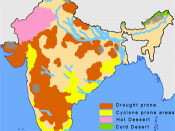MEGACITIES AND SMALL TOWNS: DIFFERENT PERSPECTIVES ON HAZARD VULNERABILITY
"In a world of uncertainty, the only constant is change and rapid change produces a
multitude of diverse facts." Risk is an integral part of life and it is based on a combination of
hazard and vulnerability. Over the past couple of decades, considerable attention has been placed
upon the studies of hazards and their mitigation processes. While no country in the world is
entirely safe, the lack of capacity to limit the impact of hazards remains a major burden for many
countries. Since the world has witnessed an exponential increase in human and material losses
due to natural and technological disasters, a need to reverse trends in hazard vulnerability exists.
The journal article by John A. Cross titled "Mega cities and small towns: different perspectives
on hazard vulnerability" closely reflected the idea of how small towns are more vulnerable to
hazards compared to megacities, due to their lack of resources, money, government interest and
numerous other factors.
At first glance, the article seemed well researched and discussed,
but further consideration proved otherwise. John Cross's failure to consider recent events
surrounding hazard vulnerability such as changing population demographics, the emergence of
new un-natural hazards and the current discussions on hazard mitigation created a major flaw,
which subsequently diminished the quality of his article.
CHANGING POPULATION DEMOGRAPHICS
John Cross's argument defined small towns as being more vulnerable to hazards than
megacities. He argued this statement by reflecting on the sense that disasters can result in equally
high percentages of deaths and economic losses among the populations of small towns compared
to those of megacities. Remoteness, isolation, openness, limited diversification, poverty and
limited capacity are factors that characterize rural communities as vulnerable. Thus the extent of
the town's vulnerability is determined by the...


